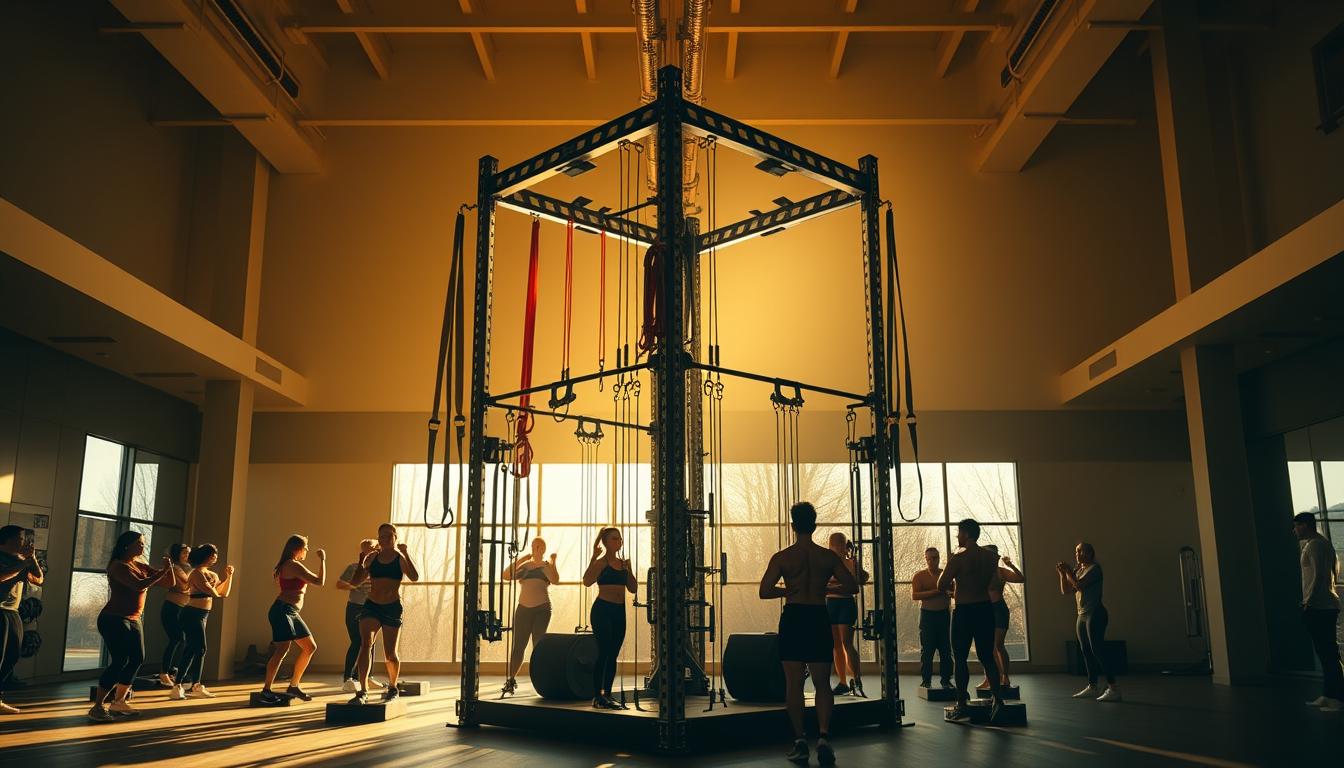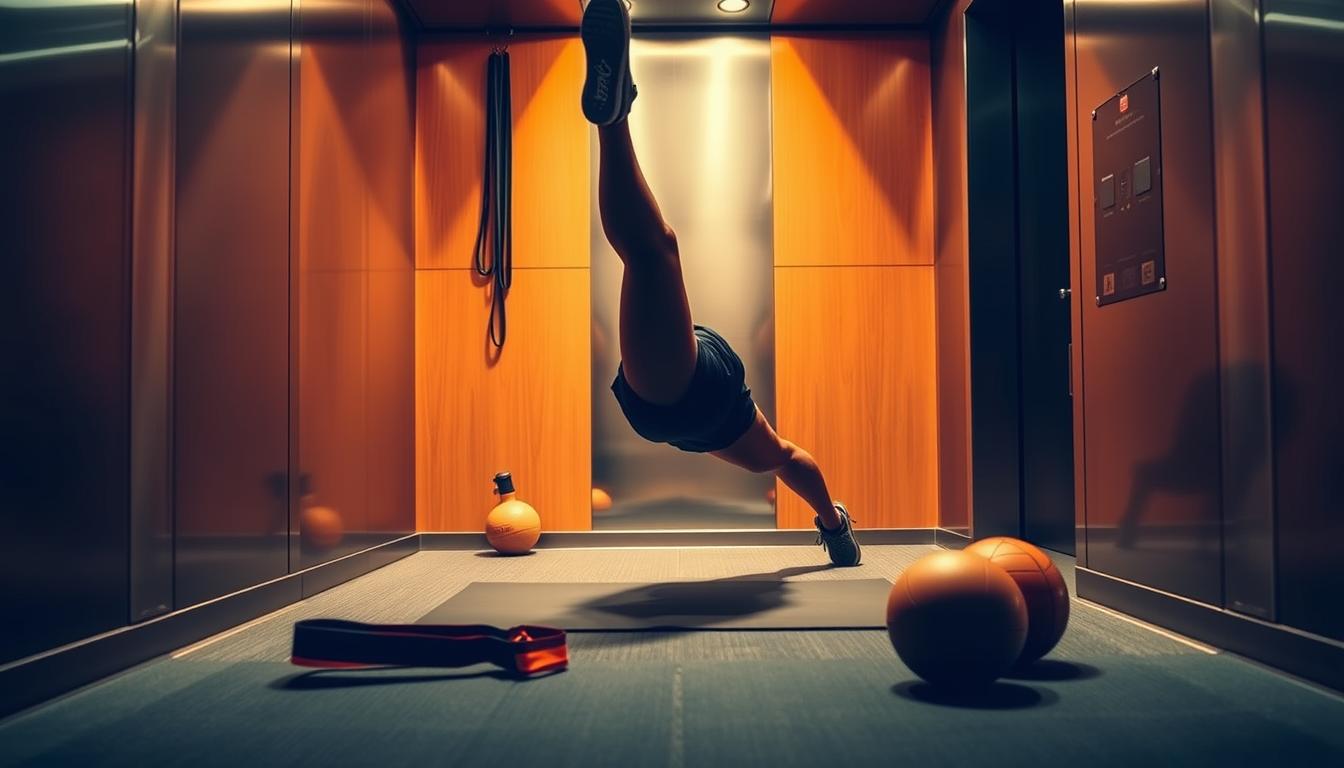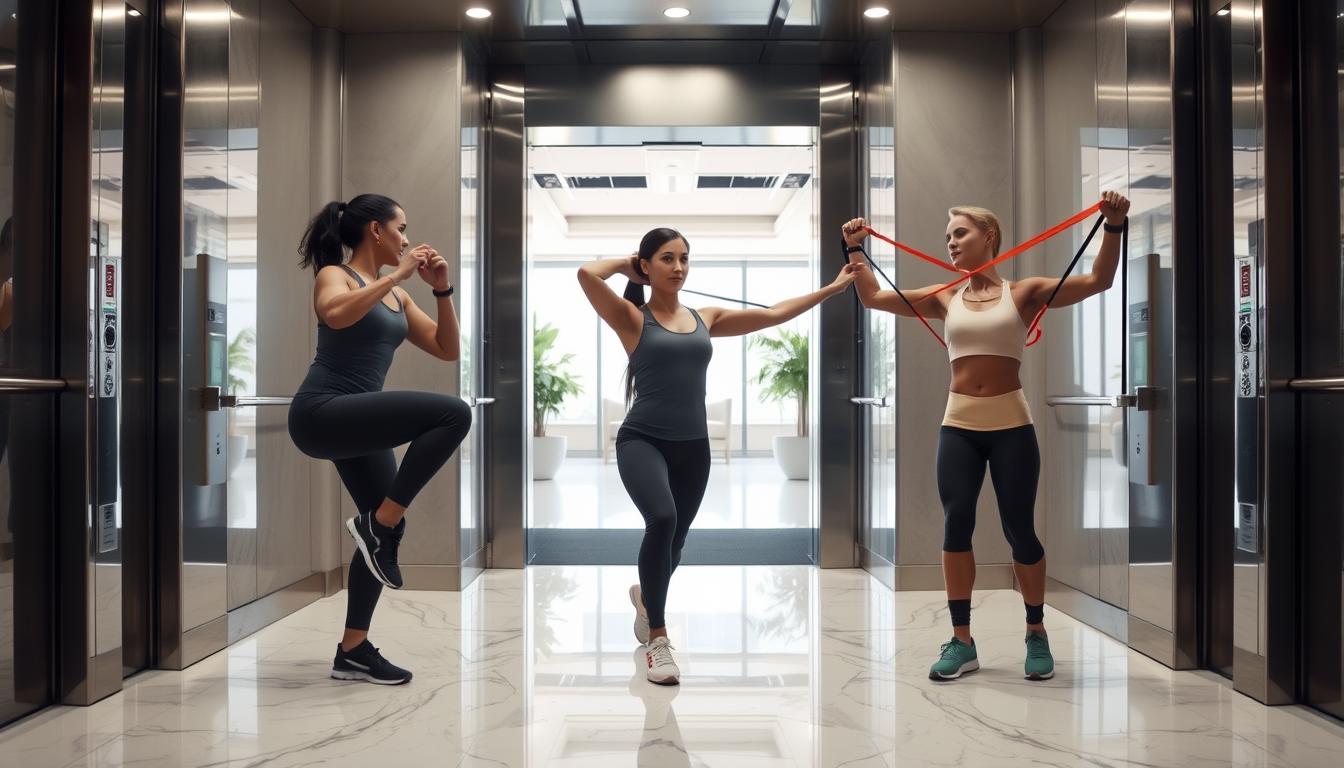In our fast world, it’s tough to stay fit at work, especially with desk jobs. Yet, small steps, like using stairs or having walking meetings, can really help. These choices fight the dangers of sitting all day and boost your overall active lifestyle.
Taking short breaks to stretch or use an under-desk elliptical keeps your energy up all day. Trying these office workouts could be the key to staying lively and focused. It shows staying active on the go is doable and good for you.
The Importance of Staying Active in a Desk Job
Spending long hours in front of a computer can lead to unexpected health issues for those not moving enough. The sedentary lifestyle of office work is linked to back pain, obesity, heart disease, and diabetes. Studies show sitting more than 7 to 8 hours a day raises these risks. So, it’s crucial to add physical activity into our daily lives.
Health Risks Associated with Inactivity
Being inactive affects not just our bodies but also our minds. An alarming 80% of Americans don’t meet the activity guidelines set by health experts. Health problems from desk jobs can show up as pain or discomfort and make us less sharp and productive at work. Knowing these risks helps us mix fitness with our work life for better health.
Balancing Work and Fitness
Mixing work and exercise doesn’t mean big changes. Small steps can make a big difference in how much we move. Taking short breaks every hour can keep us comfortable and focused. Adding a bit of walking or stretching during these breaks improves our job happiness and mental alertness. Having a water bottle nearby encourages us to walk more each time we refill it.
Setting up fun challenges, like who can step the most, makes exercise exciting. Suggesting walks for meetings or standing during calls are smart ways to stay active. Even simple choices like parking further or taking stairs add more activity to our day.
Maximizing Movement During Breaks
Moving around during breaks is really good for your physical and mental health. Taking short walks or doing stretches at work can wake you up for more work. Doing simple activities on your break can ease stress and make you healthier.
Walking Breaks to Recharge
Walking breaks can greatly improve your day. Try to use the stairs instead of the elevator if it’s just a floor or two. This helps your heart and muscles. On your break, try walking with your work friends. This can make you feel a part of something and keep you active.
Incorporating Stretching Into Your Day
Stretching at work is something you should do every day. You can do easy stretches or muscle squeezes during quick breaks. Using things like resistance bands can help keep your muscles working. Stretching for just a few minutes can make you more flexible and less stiff. Try to stand and move a bit when you’re on the phone. And do some simple leg lifts or squats while you wait for printing or heating your lunch. These small moves are important for feeling good and staying healthy.
Simple Exercises for the Office Environment
It’s tough to move around in today’s busy work life. Adding simple exercises to your day can really boost your focus and health. Doing exercises at your desk fights the stillness linked with sitting all day. Taking short fitness breaks can make your office a more active place.
Desk-friendly Workouts
There are quick and easy exercises you can do at your desk. Here are some to try:
- Desk Pushups: Lean against your desk and perform pushups for at least 10 reps.
- Calf Raises: Stand tall, lifting one leg at a time while holding for a moment, then lower. Aim for 10 repetitions on each side.
- Chair Squats: From a seated position, stand and lower your body until your buttocks almost touch the chair, repeating this for 10 times.
- Seated Knee-to-Chest: Pull your knees toward your chest while sitting, repeating this movement 10 times.
- Wall Sits: Slide down a wall into a 90-degree angle with your knees and hold for up to 60 seconds.
Using Office Furniture for Fitness
Office furniture isn’t just for work—it can help you get fit. Your everyday items can become your workout friends:
- Tricep Dips: Use a sturdy chair to lower your body, working your chest and triceps, aiming for 10 dips.
- Desk Plank: Place your hands on the desk and walk your feet back until your body forms a straight line, holding for at least 30 seconds.
- Static Lunges: Step forward and bend your knees for a 90-degree angle, returning to the starting position. Repeat 10 to 20 times on each side.
- Seated Leg Extensions: While seated, lift each leg until parallel to the floor, holding briefly before lowering. Repeat 10 times on each side.
- Seated Windshield Wipers: While seated with legs outstretched, move them side to side for 10 reps on each side.
Making the Most of Your Lunch Break
Turning your lunch break into a fitness session can change how you view work and health. It boosts your energy, makes you more creative, and helps you focus better. By mixing lunch with some activity, you can enjoy big health rewards. Getting coworkers to join in makes it even more fun and helps build healthy habits and teamwork.
Active Lunch Break Ideas
Adding short workouts to your lunch break can make you feel great. Here are some ideas:
- Group walks around the office or nearby parks to promote cardiovascular health.
- Bodyweight circuits that can be done right at your desk with no extra space needed.
- Joining a short fitness class at a gym close to work during your break.
- Pack a gym bag with stuff like makeup, face wipes, and deodorant for quick clean-ups.
- Eat a snack an hour before exercising and have your main meal when you get back to your desk.
Creating a Routine with Coworkers
Working out with coworkers can make you more likely to stick with it. When exercise is a group activity, it’s more fun. Try these tips:
- Organize regular walks or workouts with your coworkers.
- Start fitness challenges during lunch to keep it exciting.
- Find gyms close by that offer quick workouts.
- Plan workouts so everyone, no matter their fitness level, can join.
- Talk about how exercising at lunch can make you better at your job and clear your mind.
The Stairway to Fitness
Picking stairs over elevators is a smart way to add exercise into your day. Climbing stairs helps your heart get stronger and burns more calories. Making this easy switch can improve your fitness levels at work and boost your overall health.
The Benefits of Choosing Stairs Over Elevators
Stair climbing can greatly improve your health. Research shows it lowers the risk of dying early by 24% and cuts the risk of heart disease by 39%. If you climb stairs regularly, you can burn a lot of calories. For instance, someone weighing 170 pounds might burn over 500 calories in an hour. Even climbing six flights of stairs daily can have big health benefits.
Integrating Stair Climbing into Your Day
To make stair climbing more attractive, turn stairwells into welcoming areas. Use bright colors, lay down some carpet, and hang pictures related to nature or tropical scenes. Setting up signs that motivate and having contests can inspire everyone to take the stairs. The CDC’s project “StairWELL to Better Health” shows that simple changes can increase stair use at work.
- Stair climbing works your leg and buttock muscles effectively, often yielding better results for muscle building than running.
- This low-impact activity can help maintain a healthy weight by enhancing non-exercise activity thermogenesis (NEAT).
- Consider blending stair climbing with your daily routines; it can significantly contribute to achieving the recommended 150 minutes of moderate-intensity aerobic activity weekly.
- Safety during stair workouts is paramount; remain alert and avoid running to reduce the chance of falls.
Scheduling Fitness into Your Workday
Fitting exercise and work together might seem hard. But with good planning, fitting fitness into your day becomes easier. Setting aside specific times for working out can make you more productive. It also improves your health. Making time for physical activity helps build a routine that’s good for your brain and body.
Time Management for Physical Activity
To make fitness a regular part of your day, schedule short exercise breaks. Putting exercise times on your calendar keeps you on track. Here are some ways to do that:
- Set reminders to stand up and stretch every hour.
- Designate specific times for walking meetings or quick exercise sessions.
- Consider using break times to run up and down the stairs.
Short Workouts Between Tasks
Adding short exercise breaks can boost your workflow instead of interrupting it. Working out briefly between tasks can ease stress and increase focus. Here are some ideas:
- Quick bodyweight exercises or stretches at your desk.
- Utilizing office spaces for brief walk or stretch intervals.
- Collaborating with colleagues to create group fitness challenges.

Elevator Fitness Tips: Compact Workouts on the Go
It can be hard to find time to work out when you’re always busy. Compact workouts are great for those who need to fit exercise into their daily lives. You can stay active with quick cardio and workouts that don’t need much space. Let’s look at ways to keep healthy without spending too much time exercising.
Quick Cardio: In-place Exercises
Quick cardio is ideal for getting your heart rate up in small spaces. Exercises like Plank, Bird Dog, and Superman work well in tight spots, like elevators. These exercises can be made easier or harder, so anyone can do them. Workouts like Single-leg Bridge and Kneeling Squat with Jump are perfect when you’re short on time.
Stretches that Fit Your Schedule
Incorporating stretches into your day helps with muscle flexibility and reduces tension. Simple stretching routines can be done anywhere, like at your desk, to ease stress. Such routines not only improve your physical health but also boost your productivity. Making time for stretching lets you blend fitness with your everyday tasks.
Outside Work: Maintaining An Active Lifestyle
Living an active life is key for both your body and mind. Taking part in outdoor activities keeps you fit and brings your family closer. Adding exciting and fun exercises to your day can make you stronger and give you great memories. You can do anything from walking your dog to going on hikes as a family.
Family and Pet Activities
There are many ways to have fun and be active with your family. Some good ideas include:
- Daily dog walks to enjoy fresh air and exercise
- Weekend hikes on local trails to explore nature
- Biking around the neighborhood or nearby parks
- Participating in community outdoor festivals featuring fitness challenges
Community Classes and Groups
Joining local exercise classes can boost your motivation and help you meet people with similar interests. Being part of a fitness group can make exercising more fun and easier to keep up. Some popular activities are:
- Yoga or Pilates classes in local parks
- Outdoor boot camps that build strength and endurance
- Running clubs for all skill levels
- Cycling groups that explore scenic routes
By doing outdoor exercises and joining community classes, you’ll keep an active lifestyle. Plus, you’ll make friends and build a support system around exercising.
Utilizing Commute Time for Fitness
Turning commute time into a chance for fitness can really boost your health. Walking or biking to work helps your heart and cuts down sitting time. By choosing active commuting, you start your day moving and aim for better fitness.
Walking or Biking to Work
Walking or biking to work is full of perks. It keeps your heart healthy and helps you stay at a good weight. Feeling the fresh air and sunlight boosts your mood and mental health. Plus, doing this often can lower your risk of being overweight and other health problems.
Parking Strategies for More Movement
If you drive to work, there’s a way to add fitness too. Park your car a bit far from the entrance to walk more. These extra steps add up to your weekly exercise. You can also do simple exercises like:
- Standing calf raises during traffic stops or waiting periods.
- Buttock pinches while waiting for a light to change.
- Quick hamstring stretches by bending one knee and reaching for the ankle.
- Mini squat challenges during waiting times.
- Shoulder rolls to relieve tension and improve posture.
This approach enhances fitness during your commute. It helps make being active a core part of your daily routine.
Driving and Sitting Exercises
Keeping fit while driving on long trips is tough. But you can do simple exercises to ease tension. These activities help keep you well during your travels.
Postural Exercises to Relieve Tension
Good posture is key when you’re sitting for a long time. First, adjust your seat and wheel to get comfy. Keep your back straight, chin up, and stomach tucked in. Your thighs should be flat on your seat.
Do neck rolls to loosen up. Drop your chin, hold, then move it side to side. Lift your chin high and hold. These moves will make you feel better.
Simple Stretches While on the Road
Add stretches for drivers to fight off stiffness. Shrug your shoulders up high, hold them, and let go. Circle your shoulders around a few times. At red lights, lift your heels up and down.
While seated, firm up your core muscles. Then, move your hips back and forth. Tighten your backside and thighs too. This keeps your body moving.
It’s important to take breaks. Every hour, get out and walk fast for a couple of minutes. Follow these road trip fitness tips to stay flexible and full of energy on your trip.
Conclusion
This summary of elevator fitness tips shows that being active during a busy workday is both doable and important for your health. You can make a big difference in your well-being by doing simple exercises. Taking stairs instead of elevators and stretching during short breaks can boost both health and productivity. These actions help keep you moving, which is great for both your body and mind.
Keeping fit is really important. Regular exercise is good for your heart, makes your muscles stronger, and helps you maintain your weight. When you fit these activities into your day, you’ll feel happier and less stressed. This can make you more focused and creative. Just making small changes in how you spend your workday can improve your fitness a lot.
By following these tips, you start on the road to being healthier and more active. Every little bit of movement counts. Making a promise to keep moving can bring long-term benefits to your physical and emotional health. So, why not start today? Your future self will definitely be grateful!



